 |
| Category: Badges |

|
|
|
|
|
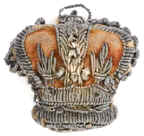 |
Crowns & Cyphers as used
on medals, badges & uniforms |
| <<< Crown
worn above chevrons (in the Ballarat Volunteer Regiment) by 2829 James
John Heath who originally served in the 55th Regiment of Foot during the
Crimean war. |
|
What is "A crown"?  |
| A crown is a symbolic form
of headgear worn by a monarch or by a god, for whom the crown is
traditionally one of the symbols of legitimacy |
|
What is "The
Crown"?  |
 |
In the British Empire, and
later the British Commonwealth (in any country or colony that recognises
the British Sovereign as Head of State, including British Dominions,
Colonies, Protectorates, Protected and Associated States, Mandated and
Trust Territories) the Crown is much more than some
jewels and precious metal and it is much more than just the King (or Queen as
the case may be). |
Government land is known
as Crown land. Anything belonging to the government is called Crown
property, and if you are prosecuted in the courts, you are prosecuted by
The Crown. So The Crown is more than just a symbol of Royalty in
the UK - it represents the state, the country and the Queen. Crown
land in Australia for example is owned by the Commonwealth of Australia
NOT the UK and not the Sovereign.
- The
term is used to separate the authority and property of the
government of THAT country from the personal influence and private assets held by the
current Monarch of a kingdom.
|
|
Crowns as used on badges,
medals, coins and uniforms  |
There are 8 crown types in
the time frame that is of most interest to us as Australian or New
Zealand military history buffs.
| 1 |
Queen
Victoria Crown |
(QVC) |
This
is really the St Edward's Crown. The same one as used by Queen
Elizabeth II. Many designers over emphasised the design and many
badge collectors now refer to it as the QVC or Queen Victoria
Crown. |
| 1a |
Guelphic
Crown |
(Albert's)
or (Hanoverian) |
Victoria's
husband, Prince Albert, was a German and this crown
is the crown of the Dukes of the House of Hanover, of which he was a
member, as were all the British Royal family. |
| 1b |
Queen
Victoria Small |
(widows) |
This
is the Queen Victoria small diamond Crown (miscalled the Widow's
Crown). |
| 2 |
Imperial
State Crown |
(Imp) |
Used
during the reigns of Victoria, Edward VII, George V, (Edward
VIII), George VI & Elizabeth II |
| 2a |
Imperial
Crown (rebuilt) |
(Imp) |
This
crown was rebuilt in 1937 for George VI |
| 3 |
Tudor
Crown |
(King's
or KC) |
Used
during the reigns of Edward VII, George V, Edward VIII, George VI.
(Nicknamed "Teddie's
Hat" during Edwardian times) |
| 3a |
Naval
Crown |
(Tudor
naval) |
A
much older version of the a crown from Tudor times as used by the Royal Navy, Australian Merchant
Navy & others. |
| 4 |
St.
Edward's Crown |
(Queen's
or QC) |
Used
during the reign of Elizabeth the First, Victoria, Edward VII and
Elizabeth II. The
"coronation crown". |
|
| In
the days of Victoria & Edward VII particularly and the others to a lesser
degree there has been a lot of variation in the way that the crowns on badges were
portrayed by designers. Sometimes the lines of difference were blurred
so much that it is hard to tell which crown was intended. |
|
Uses made of the Crown on
uniforms  |
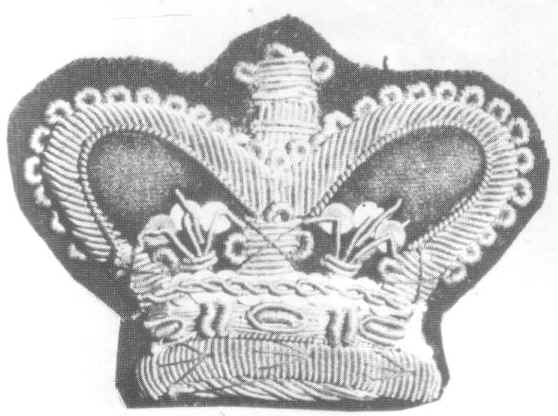 |
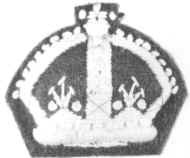 |
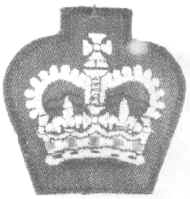 |
| Crown
of Company Sergeant Major c.1893 (worn above chevrons). |
Crown
of Colour Sergeants and Sergeants on the Staff (Staff Sergeants) worsted
c.1912. |
Warrant
Officer Class 2, 1960 |
|

|
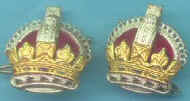 |
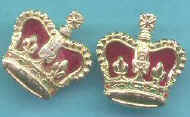
|
| Large
Tudor Crown rank badges for WO1/WO2 |
Pair
of Tudor Crown rank badges for Major 1950. |
Pair
of St. Edward's Crown rank badges for Major 1960. |
- The crown has be used at various
time to indicate rank of
- Colour Sergeant
- Warrant Officer Class 1
- Warrant Officer Class 2
- Major
- other senior ranks when
used in conjunction with other symbols
- In early days when worn as a collar
badge it indicated the status of Commissioned Officer but not a
particular rank.
- The crown surmounted by a
crowned lion has also been used for different ranks and badges.
Details of that are on History of the Crowned Lion on Crown badge
|
 |
WW2
rank insignia for Major in oxydised, gilt, silver and silver with red
felt insert for dress uniform. Tudor or King's Crown. |
 |
Queen
Victoria Crown  |
| This
is really the St Edward's Crown. The same one as used by Queen Elizabeth
II. Many designers over-emphasised the design and many badge collectors
now refer to it as the QVC or Queen Victoria Crown. While it is
technically incorrect to do so it is in such common usage that it is
accepted as "true". |
 |
 |
 |
| As noted
elsewhere some of these may have been intended to be Imperial State
Crowns not the QVC. Designers took liberties with designs that would not
be accepted today. |
 |
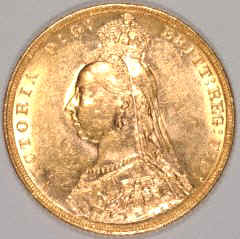
|
This Crown was made for
Queen Victoria in 1870 and can be seen in many of her portraits.
image www.chards.co.uk
<<
Obverse of a gold sovereign from later in the reign of Victoria, 1887 |
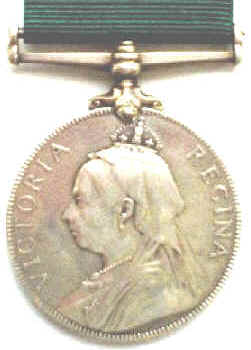
20 years Service Medal
|
In
1870 Queen Victoria, finding the Imperial State Crown too heavy,
designed and commissioned this delightful small crown to be made, using
some of the diamonds from her own collection - mainly from a large
necklace.
Queen Victoria's Small Diamond Crown
measures 3.7 inches (9.9 cm) high and 3.4 inches (9 cm) in diameter. It
was worn atop a widow's cap.

|
|
The crown was made in 1870, using some
1,300 diamonds from a large necklace and other jewelry in the Queen's
personal collection. It
was deposited in the Tower of London in 1927, by King George VI.
As can be seen it was used on coinage
and on medals including medals awarded to Australians and New
Zealanders.
|
|
Other versions of the
Victoria image  |
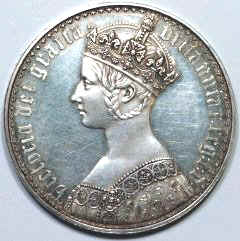 |
Queen Victoria (the
"gothic head")
This is the image of the
young Victoria, 1847. It is referred to as the "gothic head".
This design was seen on coinage and medals in the time frame we are
interested. Note the Imperial State Crown.
|

|
Another image used for the
young Victoria had her wearing a tiara style crown.
|
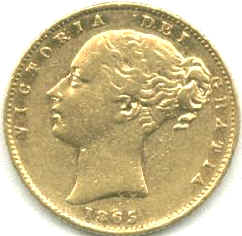 |
Other images were used with
the Queen uncrowned. This was 1865
image www.chards.co.uk
|
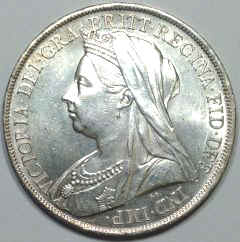 |
Queen Victoria (the
"old head")
This image of an older
Victoria was adopted from 1893 for silver and gold coins, and from 1895
for bronze coins, and was continued until Victoria's death in 1901. It
was the third major portrait type of Victoria's reign.
Called by some the "widow's
head", although that is not particularly accurate as Prince Albert
had died in 1861, and the "old head" was not used until 1893.
image www.chards.co.uk
|
|
Imperial State
Crown  |
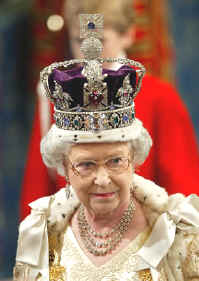
QE II wearing the Imperial State Crown,
2004 |
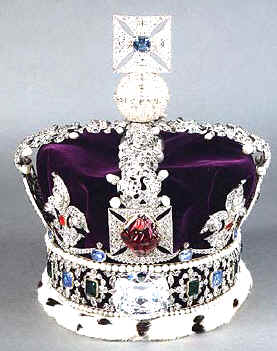 |
Used on medals
or badges during the reigns of Victoria, Edward VII, George V, (Edward
VIII), George VI & Elizabeth II. |
| The Crown is
of a design similar to St Edward's Crown but flatter topped: it includes
a base of four crosses pattee alternating with four fleurs-de-lis, above
which are four half-arches surmounted by a cross. Inside is a velvet cap
with an ermine border. The Imperial State Crown includes several
precious gems, including: 2,868 diamonds, 273 pearls, 17 sapphires, 11
emeralds, and 5 rubies. It includes several famous jewels. The Cross
atop the Crown is set with a sapphire taken from the ring of Edward the
Confessor. The Black Prince's Ruby is set on the front cross pattee.
Furthermore, the famous Cullinan II, or Lesser Star of Africa, is set on
the front of the Crown.
It is generally worn at the end of a
coronation when the new monarch departs from Westminster Abbey, though
it was actually worn during the ceremony by Queen Victoria and King
Edward VII, both of whom complained about the weight of the normally
used crown, St Edward's Crown. Furthermore, it is worn annually by the
Queen at the State Opening of Parliament. Traditionally, the Crown and
other jewels leave in their own carriage and arrive at the Palace of
Westminster prior to the Queen's departure from Buckingham Palace. They
are then transported to the Robing Room, where the Queen dons her robes
and wears the Crown. |
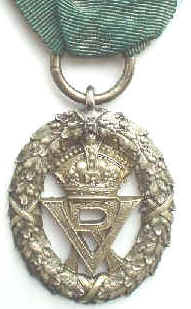 |
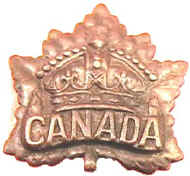
Canada 1914
<< UK
& Empire c1900
|
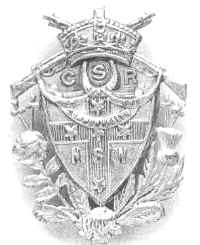
New South Wales 1903 |
 |
Imperial
State Crown (rebuilt in 1937)  |
| The present crown is
about the tenth manifestation since the Restoration. It was originally
designed and made for Queen Victoria in 1838 to indicate that she was
Empress of India. It was used at the
coronations of Edward VII and George V. It was remade with practically
the same stones for George VI in 1937. Some of the world's
most exceptional and historic precious stones are to be found adorning
objects in the collection of crowns & regalia. Among them Cullinan
I and Cullinan II, the two largest top-quality cut diamonds in the
world and the extraordinary and ancient Koh-i-Noor diamond. Other
famous stones include the Stuart Sapphire, the Black Prince's Ruby,
and St Edward's Sapphire all set in the Imperial State Crown. |
| A large
"Balas ruby" (called the Black Prince's Ruby) is now set into the British Imperial State Crown.
It measures five centimeters long and weighs about 150 carats. Balas
rubies (red spinel) are said to have the same properties as genuine
rubies and protect owners against ill fortune. |
|

|

|

|
| Australia
c1930 |
Imperial
Service Medal |
Fiji
Independence Medal |
-
The Imperial State Crown
is worn on only two occasions. In addition to the State Opening of
Parliament, it is worn by the monarch for the return to Buckingham
Palace following a coronation ceremony.
-
St Edward's Crown is the Crown
with which ALL sovereigns are "crowned" during the Coronation Ceremony
|
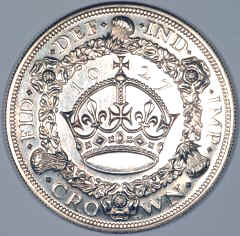 |
Tudor
Crown  |
| The Tudor
Crown (miscalled the King's Crown)
has a rounded top.
image www.chards.co.uk
It was introduced by Edward VII in about 1902 and
was in use until the accession of Elizabeth II in 1953 when it was
replaced by the St. Edwards Crown.
Image is a variation of the Tudor Crown as used on a
coin called "a crown" of 1927 during the reign of George V.
|
The naval crown (made up
of alternate sterns and topsails) can be traced back to the Romans when
a crown ornamented with a design of the 'rostra' or beak heads was
awarded for bravery and was known as the 'Rostral Crown'. It can be seen
on certain British Naval medals at the end of the sixteenth century. One
of the earliest examples of the Naval crown in, practically its present
form, is that which appears above the Arms of Greenwich Hospital dating
from about 1700. The decoration, however, is wholly of square sails
without the interspersed sterns. [National Maritime Museum web-site]
The British standard pattern was designed by Everard Green, Rouge
Dragon, and approved 27 July 1903. Design was revised in 1922, approved
by Naval Law Department NL 7350/22, and issued as Admiralty Fleet Order
3228/22. [National Archives (PRO) ADM 1/11609] |
|

|
| Coronation
medal of King Charles II, 1661. Left:
Crowned bust of King Charles II. Right:
The King enthroned, crowned by Peace hovering above. By Thomas Simon
(signed T.S. below the bust). Silver. 29 mm. (1.15 inches) in diameter. |
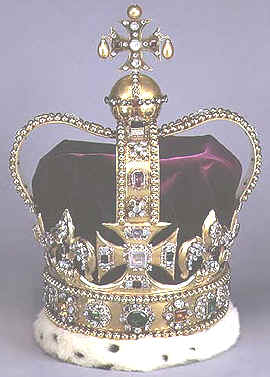
|
<<<
The
magnificent solid-gold St Edward's Crown made for the coronation of
Charles II and used, most recently, to crown Queen Elizabeth II in 1953.
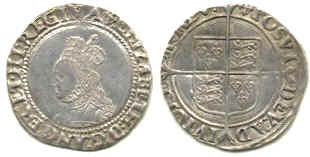
Elizabeth I shilling of her second
coinage1560-61
mintmark: crosslet
A similar crown
was also
worn and used by Queen Elizabeth the First, 100 years earlier.
|
| St Edward's
Crown. Refurbished for Charles II's coronation from an old crown; the
gold may have come from Edward the Confessor's crown. |
|
|
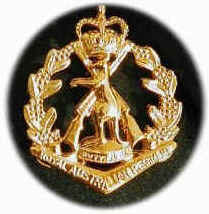 |
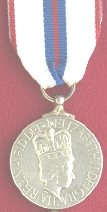
|
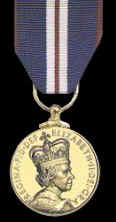
|
| RAR
hat badge |
Silver Jubilee medal |
Golden
Jubilee medal |
|
The 4 portraits of QEII used
on coinage |
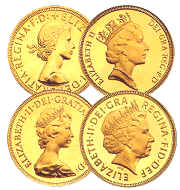 |
The first coinage portrait
of Her Majesty was a portrait by Mary Gillick adopted for the earliest
coins in her reign and issued from 1953. This portrait shows the Queen
wearing a wreath.
For the decimal coins of 1968 a fresh
portrait was adopted by Arnold Machin OBE,RA. The Queen is seen wearing
the tiara given as a wedding
present from her grandmother Queen Mary.
The third change in portrait was by
Raphael Maklouf FRSA. The design shows the Queen with the
Royal Diadem which she wears on
her way to and from the State Opening of Parliament. |
| The portrait
introduced in 1998 is the work of sculptor Ian Rank-Broadley FRBS, FSNAD.
It is only the fourth portrait of Her Majesty the Queen to appear on
coins of her long reign. Her Majesty is wearing the tiara
which was used in an earlier coinage portrait by Arnold Machin.
The Queen continues to be shown facing
right, in accordance with a tradition dating back to the seventeenth
century, where successive monarchs face in alternative directions on the
coinage. |
 from a British Government site
from a British Government site |
Question.
It is often remarked that, upon the accession to
the Throne of the present Queen, the Crown above the Royal Cypher and the
symbol of the State changed from the so-called "King's Crown" to
the "Queen's Crown". The former resembles the Imperial State
Crown (prior to the lowering of the arches in 1953) and the latter looks
more like the Coronation Crown of St. Edward. Was this change made simply
because the monarch was a Queen Regnant (and if so, is it not true that
Queen Victoria used the "King's Crown" in the latter part of her
reign)? Or was there some other reason for the change?
Answer.
You are correct in saying that the present Queen's cypher
incorporates a representation of St. Edward's Crown, with upright, domed
sides, whereas George VI's cypher featured a Tudor Crown with sloping sides more
like the Imperial State Crown.
However, there are no strict rules regarding the changes in crown
design used in a Royal cypher, nor is there a King's Crown used for male
monarchs as opposed to a Queen's Crown for female monarchs. The cypher
design changes, as does that of the coat of arms, upon the accession of a
new monarch, and the new cypher is always different from the preceding
monarch's. The design change may include the adjustment of the shape of
the crown to distinguish the cyphers.
One discernible trend is that sovereigns named Edward - Edward VII and
Edward VIII, for example - have tended to use St. Edward's Crown in their
Cyphers, by virtue
of the name association.
During Victoria's reign, the design of the cypher was not standardised
and so there were variations in the shape of the crown featured in
different media during her long reign.
http://www.royal.gov.uk/output/page2494.asp
|
|
A private collection of
Crowns as used on Aussie uniforms |
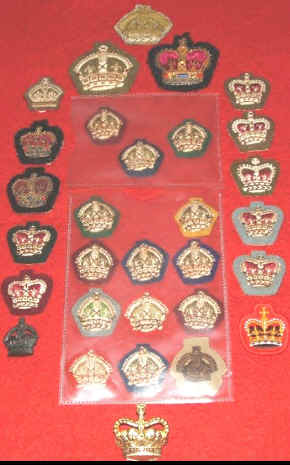 |
- Click the image to enlarge it. If
it auto-reduces, Click the ICON.
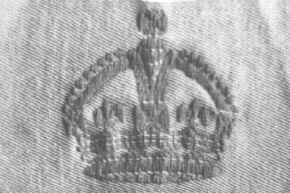
(Above) AIF
Volunteer badge.
It was a red
crown on khaki and was worn by
members of the Forces, regardless of rank, that had volunteered for Active Service but who
had been retained for service in Australia as "essential
personnel".
|
|